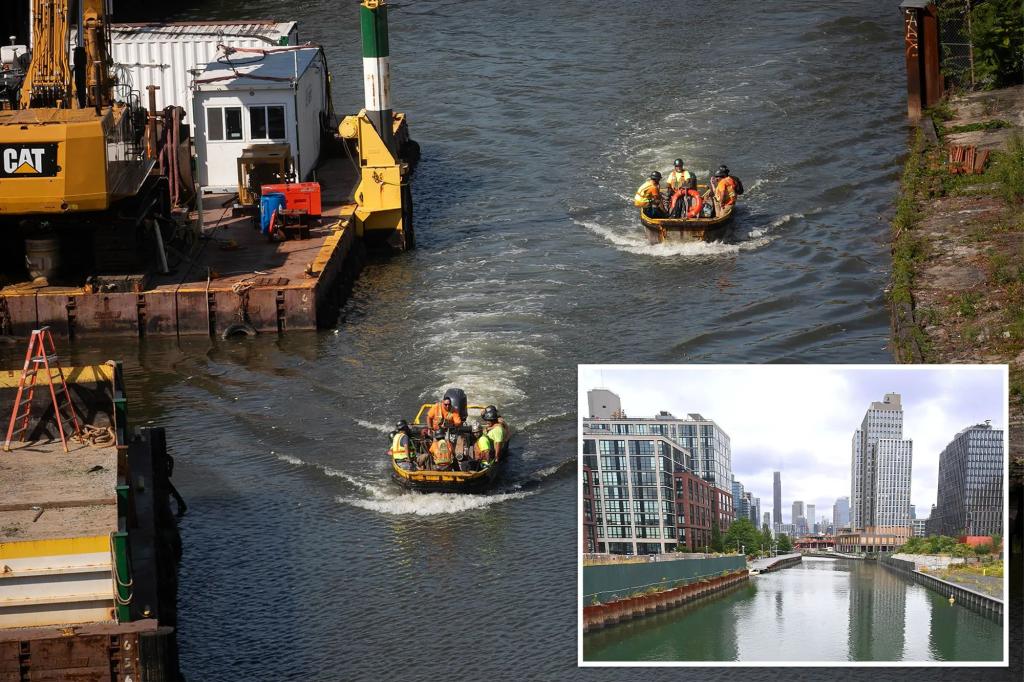It’s a murky situation.
Experts are sounding alarms about the EPA’s plan to excavate the Gowanus Canal without covering the foul-smelling sludge — as residents allege they’re suffering from putrid air and fear more toxins could be released into their tony neighborhood.
In dual letters sent to the EPA last week, NYU’s Grossman School of Medicine and Pace University’s Environmental Law Clinic accuse the agency of being as murky as the polluted canal’s waters with the facts behind their project to install a massive, underground storm water tank in the area.
“We are deeply concerned about the lack of transparency and community engagement in this decision-making process, particularly given that the community has been subjected to foul odors for months from this highly toxic site during this critical phase of the Gowanus Canal Superfund cleanup,” one letter, penned by Pace Environmental Litigation Clinic Managing Attorney Todd D. Ommen, reads.
Ommen added his clinic is “troubled” by the lack of “any formal documentation or scientific analysis supporting the decision” to dig without “tenting,” or covering the canal.
The EPA, however, claimed in December that it wouldn’t be possible to “tent” the dig sites to contain the foul smell, and said such covering would add over a year to the project’s timeline. Officials also said that they would have to close Nevins Street to put a covering on the site and it would create noise issues.
But the letter writers contend federal officials didn’t sufficiently defend the harmlessness of its plan, and is set to embark on a dig with a “lack of critical safety ‘guardrails.’”
The news comes months after “shockingly high levels” of the cancer-causing chemical trichloroethylene were found inside homes and buildings near the canal. The state is doing tests on nearby residential buildings — but only if locals can talk their landlord into letting the state come on their property.
A request for comment from the EPA was not immediately returned.
The dig is part of an 8-million-gallon underground retention tank project slated to hold sewage and rainwater during storms inside the “black mayonnaise”-caked canal, which was designated to the EPA’s National Priorities List in 2010. The project’s second phase is slated to begin this summer with soil excavation that will dig up over 100-year-old waste.
“We believe this excavation option has the potential to release harmful toxicants into the environment,” reads the letter from NYU’s Grossman School of Medicine, penned by Dr. Judith Zelioff and a team of environmental toxicologists.
Zelioff noted that prolonged inhalation or skin exposure from some compounds found in coal tar can lead to an increased risk of cancer, as well as harmful reproductive, cardiovascular and pulmonary effects – which could be felt as far as a mile or two from the canal site.
Despite reported health concerns from residents, Gowanus has seen an abundance of high-end development in recent years — with some studio apartments leasing for upwards of $3,000 per month.
The NYU letter also contends the EPA isn’t measuring one type of particulate matter “considered the most toxic for human health and a lung carcinogen,” and that, as the current plan will unequivocally impact nearby Gowanus Houses and Wyckoff Gardens, it requires the “careful consideration of cumulative environmental and public health impacts” on the designated “disadvantaged community” under state climate law.
Zelioff furthermore echoed some residents’ concerns over idling diesel trucks and the transportation of the toxic sludge being hauled away from the site, with just a non-airtight tarp separating the stuff from Big Apple residents.
“Depending on weather and wind conditions, such materials can be distributed throughout the community,” Zelioff wrote, “as well as nearby areas and poses a potential risk to residents, particularly those of greatest vulnerability.”
Read the full article here

